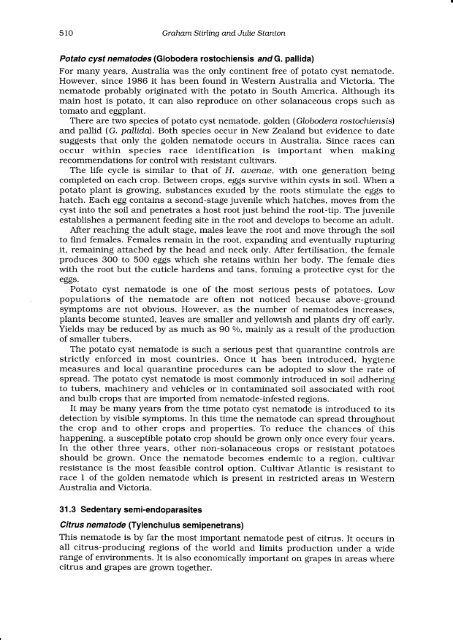NEMATODE DISEASES AND THEIR CONTROL Graham Stirling ...
NEMATODE DISEASES AND THEIR CONTROL Graham Stirling ...
NEMATODE DISEASES AND THEIR CONTROL Graham Stirling ...
You also want an ePaper? Increase the reach of your titles
YUMPU automatically turns print PDFs into web optimized ePapers that Google loves.
510 <strong>Graham</strong> Strrling andJulie Stanton<br />
Potato cyst nematodes (Globodera rostochiensis andG. pallida)<br />
For many years, Australia was the only continent free of potato cyst nematode.<br />
However. since 1986 it has been found in Western Australia and Victoria. The<br />
nematode probably originated with the potato in South America. Although its<br />
main host is potato, it can also reproduce on other solanaceous crops such as<br />
tomato and eggplant.<br />
There are two species of potato cyst nematode, golden (Gtobodera rostochiensis)<br />
and pallid (G. paLLida). Both species occur in New Zealand but evidence to date<br />
suggests that only the golden nematode occurs in Australia. Since races can<br />
occur within species race identification is important when making<br />
recommendations for control with resistant cultivars.<br />
The life cycle is similar to that of H. duenae, with one generation being<br />
completed on each crop. Between crops, eggs survive within cysts in soil. When a<br />
potato plant is growing, substances exuded by the roots stimulate the eggs to<br />
hatch. Each egg contains a second-stage juvenile which hatches, moves from the<br />
cyst into the soil and penetrates a host root just behind the root-tip. The juvenile<br />
establishes a perrnanent feeding site in the root and develops to become an adult.<br />
After reaching the adult stage, males leave the root and move through the soil<br />
to find females. Females remain in the root, expanding and eventually rupturing<br />
it, remaining attached by the head and neck only. After fertilisation, the female<br />
produces 3OO to 5OO eggs which she retains within her body. The female dies<br />
with the root but the cuticle hardens and tans, forming a protective cyst for the<br />
eggs.<br />
Potato cyst nematode is one of the most serious pests of potatoes. Low<br />
populations of the nematode are often not noticed because above-ground<br />
symptoms are not obvious. However, as the number of nematodes increases,<br />
plants become stunted, leaves are smaller and yellowish and plants dry off early.<br />
Yields may be reduced by as much as g0 o/o, mainly as a result of the production<br />
of smaller tubers.<br />
The potato cyst nematode is such a serious pest that quarantine controls are<br />
strictly enforced in most countries. Once it has been introduced, hygiene<br />
measures and local quarantine procedures can be adopted to slow the rate of<br />
spread. The potato cyst nematode is most commonly introduced in soil adhering<br />
to tubers, machinery and vehicles or in contaminated soil associated with root<br />
and bulb crops that are imported from nematode-infested regions.<br />
It may be many years from the time potato cyst nematode is introduced to its<br />
detection by visible symptoms. In this time the nematode can spread throughout<br />
the crop and to other crops and properties. To reduce the chances of this<br />
happening, a susceptible potato crop should be grown only once every four years.<br />
In the other three years, other non-solanaceous crops or resistant potatoes<br />
should be grown. Once the nematode becomes endemic to a region, cultivar<br />
resistance is the most feasible control option. Cultivar Atlantic is resistant to<br />
race I of the golden nematode which is present in restricted areas in Western<br />
Australia and Victoria.<br />
31.3 Sedentary semi-endoparasites<br />
Citrus nematode (Tylenchulus semipenetrans)<br />
This nematode is by far the most important nematode pest of citrus. It occurs in<br />
all citrus-producing regions of the world and limits production under a wide<br />
range of environments. It is also economically important on grapes in areas where<br />
citrus and grapes are grown together.






![[Compatibility Mode].pdf](https://img.yumpu.com/27318716/1/190x135/compatibility-modepdf.jpg?quality=85)










